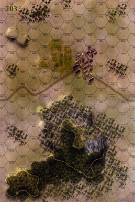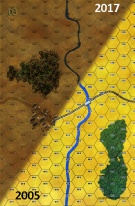| Author |
treadasaurusrex
(Poland) |
| Method |
VASSAL 
|
| Victor |
Germany |
| Participants |
NBGB |
| Play Date |
2024-03-21 |
| Language |
English |
| Scenario |
DelP022
|
This was a pleasant & fun 3-session play-through with the bold & daring NBGB, commanding elements of the German 1st Panzer Division attacking across a minor river (the Brda?). I led the defending Poles of the Wolynska Cavalry Brigade, supported 2nd light Tank Battalion. We used with the FOW (beginning on game turn 15), extended assault, smoke/illum, consolidation, strategic movement, tank riders and excess initiative optional rules. Both sides drew decent sets of leaders, and my gracious opponent allowed the Poles to begin the game in hidden mode. We used these 2 house rules: 1) Road Movement for Mechanized & Foot Units - All FOOT & MECHANIZED units may move on roads at the rate of 1/2 a Movement Point (MP) per road hex, just like MOTORIZED units, and 2) Standardized Movement for Mechanized Units - All mechanized units may move through clear hexes at a movement cost of only 1 movement point (MP) per hex, instead of 1 1/2. Add one to this cost if moving up, across, or down slopes hexes.
The action-packed, initial session (game turns 1-6) featured a methodical German movement to contact in the center, with infantry probes out front looking for hidden Polish positions. The defenders began madly digging-in wherever they could and popping off the occasional ineffective oppfire as the Germans crossed the minor river and entered Map 103. By session’s end, the Poles had lost 2 steps of light tanks in an attempt to delay the inevitable and reduce German observation by combined arms, close assault. German armor began appearing from the east edge of the battle map on the 6th game turn. A combined FOUR combat 7-die rolls were thrown this session.
Our costly & exciting second session (game turns 7-11) featured heavy casualties on both sides beginning with a successful long-range AT ambush that resulted in the loss of the first German Pz-I light tank platoon in the southern Margin of Map 3. This was to be one of the very few Polish highlights this session, as the Germans pushed steadily to the east and brought the bulk of their armor over the river in a broad left flank movement across the northern half of the battle map. Axis OBA was finally able to eliminate the single Polish 81mm mortar platoon, and a well-led Landser close assault in the trees destroyed the Poles evil, AT gun platoon. The thrust of the German attack slowly veered to the left, and a combined arms, Polish counterattack in the center collapsed in the face of very effective adjacent-hex direct fire and AT crossfires. The Germans threw excellent combat, morale recovery and opportunity fire die rolls for virtually the entire session. By the end, the step loss tally was now: 16 for the struggling Polish defenders, and only 7 for the German side. Both sides lost a stage of initiative in the 9th game turn, and the Polish level fell again in the 11th. The revised victory point totals were: 17 for the Poles, and 16 for the surging Germans. Only a combined FOUR combat 7-die rolls were thrown, but all came in key situations to the dismay of the defending Polish side.
The thrilling & unpredictable third session (game turns 12-17) featured a great deal of maneuver and many complex decision points for both sides, but particularly in connection with the fighting withdrawal of the Poles back to the town. The PG Fates were on the side of the Third Reich, today, as their die rolling was excellent, particularly as regards combat and morale recovery. The landsers and their fast moving tanks maintained considerable pressure on the retreating Polish force, while moving two complete columns of light armor off the east map edge, and avoiding the town all together. The step loss tally ended at: 10 for the Germans, and 29 for the hapless Poles. The final victory point totals were: 53 for the victorious Germans, and 20 for the defending Poles. A major Axis victory that was conceded by the Polish side during game turn 17 when it became apparent to both players that the battle was lost.
This was a massively gamey, unnecessarily long, and not properly play tested scenario that is a very hard pull for the sparsely-equipped Polish defenders. The Poles should be allowed to dig-in at the start and to have all units begin in hidden mode, to make this a bit of a challenge for the surging Germans. It was fun to try out the Polish light tanks, but they proved to be of limited use, and not a real match, once the Axis force was completely deployed in echelon. We give this one a genero.us 1, and recommend it as best suited for SOLO play, or perhaps as an introductory scenario in shared play.
|






 DelP021
DelP021 

























